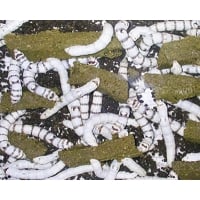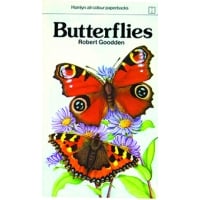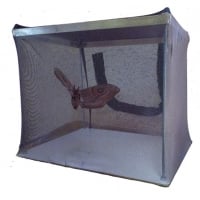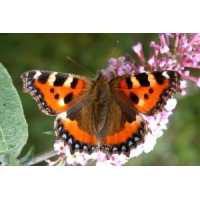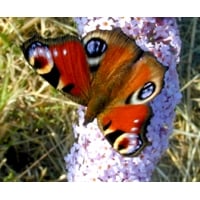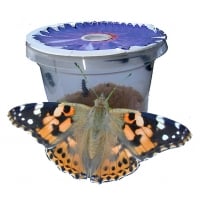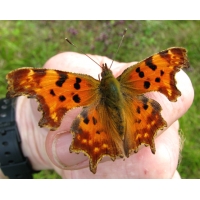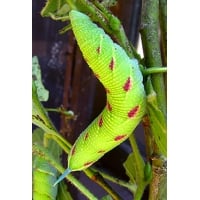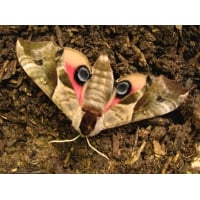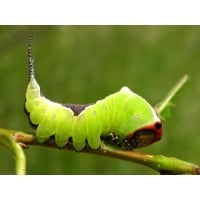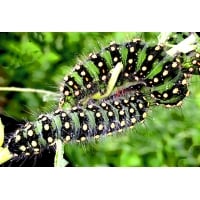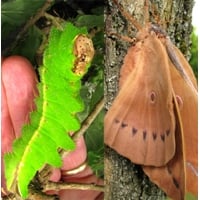SCHOOLS Recommended Livestock
If you are a beginner and need information on rearing from small caterpillars, or hatching out pupae, please order the All Colour Paperback BUTTERFLIES. INSTRUCTIONS ARE NOT SENT WITH EACH SPECIES, you need to acquire basic skills and this book is a simple way of doing so. Please read the Plastic Rearing Container section for advice on rearing young caterpillars which must have nursery treatment while they are not large enough to be kept in cages. This information is enlarged upon in the paperback guide referred to above.
We do not invoice: please use school or personal credit card to order on this website, and reclaim with the invoice printed from your account.Thank you.
Artificial Mulberry Diet powder for 20 Silkworms
Until now it has not been possible to rear silkworms without their natural foodplant Mulberry. Mulberry is often difficult to find but we are now able to offer a very convenient artificial diet that can be used as a substitute food, in any part of the world and at almost any time of the year, providing you can keep the silkworms at 25-28 degrees C. Eggs supplied in November/December will need to be refrigerated for 8-12 weeks before incubation.
The diet is sent as a sachet of powder that is easily prepared in the kitchen. It comes packeted to give sufficient food for the entire life of the silkworms, enough for 20 Silkworms. The powder can be kept for a year or more in a fridge. Made up diet can be refrigerated and kept for a month or more. Silkworms fed on diet will usually change to leaf if required, but if fed at first on leaf, they will not usually take to the diet. The life of a silkworm kept at the required temperature is about 5 weeks.
Artificial diet takes a lot less time and trouble than rearing on leaf. More importantly this enables rearing when Mulberry cannot be obtained. Eggs supplied in November - January will need to be refrigerated for 8-12 weeks before incubation. Rearing Silkworms is very educational and suitable for schools and families.
All Colour Paperback BUTTERFLIES Robert Goodden.
No other book gives such plain and practical advice for the study of butterflies and moths.
A comprehensive guide - outlining techniques for the breeding and study of butterflies and moths. This book also shows a grand selection of butterflies of every continent. Packed with essential information, colourful pictures and diagrams by the butterfly artist JOYCE BEE. Paperback. 160 pages. 7 x 4". An essential guide for the beginner.
This book went out of print many years ago. WWB bought the entire stock of the English language edition. Stocks have now sold out. There are some used copies, damage or marking mainly on the covers, which does not materially affect the content. Even these are now down to rather few copies.
Published by Hamlyn. Available only from Worldwide Butterflies.
Pyjama Mini Cage 22 x 29 x 25cm high
This popular cage has just got even better. Nearly a third larger, and much improved dimensions.
Ideal as a beginner's cage, but also for the busy breeder who wants separate small cages. Excellent as an emerging cage for chrysalides and cocoons, ideal for keeping small numbers of larvae or other insects, when large enough for cage rearing.
This cage is suitable for laying out small numbers of pupae to emerge. Also for rearing smaller numbers of larvae or smaller larvae. Baby larvae should be first reared in plastic rearing containers or kept covered on growing food. Please see the note on the page for plastic rearing containers. This cage will hold small covered pots of plant, and larger sizes of cage are available for larger subjects.
When necessary the netting cover can be slipped off for cleaning or replacement. The Pyjama Mini cage is assembled in minutes and easily packed flat for winter storage. As the interest grows there are larger sizes available. For the experienced breeder the Mini Cage has many uses where a series of smaller cages is needed for separating species and giving different treatment.
The cover can be washed by hand or machine, making your used cage like new for almost no effort, and no cost.
EARLY Small Tortoiseshell Aglais urticae
One of the best species for young people and beginners. Larvae are sent in April/May. The best way to keep the young caterpillars is on potted nettles which should be prepared in early spring , regularly watered, and kept out of doors to make stocky growth. Prepare more than one pot of nettle. When the young larvae are received, bring the potted nettle indoors and place the young larvae on the foodplant, where they will look after themselves until they finish the food and are large enough to be kept in a cage on cut nettle in a jar of water. In a matter of weeks the pupae are formed hanging from the cage top, and the butterflies emerge in a little over a fortnight.
The butterflies can be kept in a cage for a few days, with plenty of flowers for nectar, and then released to help the wild populations.
Keeping two species of larvae together on the same foodplant? It is sometimes possible, but their way of life may differ and we recommend keeping them separately.
EARLY Peacock Butterfly (Inachis io)
Peacock and Small Tortoiseshell populations are seriously depleted recently, due to the butterflies waking in the mild winter and dying of starvation. This is a a chance to help local Peacock populations.
The larvae live in tight clusters on the tips of nettle. Young larvae do best on potted nettle. Keep the pots outside until needed indoors for the first larvae. When the larvae are larger, keep them caged on cut stems of nettle in a jar of water. Pupae are formed in a matter of weeks, hanging from the cage top. Butterflies emerge in about 3 weeks. They can be kept for a few days in a cage with flowers for nectar, then released into the wild.
Keeping two species of larvae together on the same foodplant? It is sometimes possible, but their way of life may differ and we recommend keeping them separately.
Five Painted Lady larvae in Total Environment Pot
Available only for delivery to GB addresses, not international orders.
The five Painted Lady caterpillars live their whole life inside the see-through pot which contains all they need from birth to pupating. You need add no food. You don’t even clean them out and they look after themselves over weekends!
The larvae grow quite quickly in summer indoor conditions (never keep them in direct sunshine). The container is easily passed round a group without disturbance to the larvae.
During skin change the larvae do not move or eat This may last a day or two.
Don't be alarmed by this: it is a natural stage in their development.
When the larvae have finished eating, they suspend themselves from a silk pad spun on special absorbent paper in the lid. Here they cast their caterpillar skin. If you are lucky and look at the right moment you can see the actual moment of change from caterpillar to chrysalis.
Let the chrysalis harden for a couple of days, then hang the paper pinned inside a cage for the butterflies to emerge.
You can keep the butterflies for a few days in a cage with nectar flowers. Then, except in the colder months October to March, release them into the wild where they may breed naturally in your area. Please keep the larvae and pupae in an even room temperature (around 18-22º) day and night. Keep away from direct sunlight or a direct heat source such as a radiator.
The instructions are printed above - please note them for the arrival of the larvae which are not sent with further instructions. If you are sending larvae as a present, please remember the recipient will not have these instructions, unless you copy them to the recipient.
Can be ordered in advance. During the season there may be a delay of a couple of weeks or more if larvae are not currently at the size for sending.
Comma Butterfly Polygonia c-album
Fascinating larvae with curious half and half markings in black, brown and white, mimicking a bird dropping. The larvae feed on Stinging Nettle, Elm and Hop. Also Sallow, Osier Willow Salix viminalis, and sometimes other Willows. They live singly. Fast growing.
Young larvae will succeed best if placed on growing foodplant. Enclose plant and pot in a netting sleeve, tied at both ends: size 3 is ideal. Otherwise you can sleeve Comma larvae on branches of Elm, Sallow and Willows, including Osier. Good ventilation is required. Cut food is not recommended at least until the larvae are nearly half grown. Comma larvae do not like crowding, and do best kept so that each caterpillar can get away and live on its own. Disease can occur if conditions are not perfect. If it does, it helps that the larvae live separately. Any infected or dead larvae should be removed and disinfection should be carried out, lightly spraying 10% bleach solution, which will not affect healthy larvae, but does help prevent the spread of disease.
This garden butterfly is capable of re-colonising places where it used to be. In autumn the butterflies are very partial to fallen fruit. With some help this butterfly could be encouraged to spread.
Keeping two species of larvae together on the same foodplant? It is sometimes possible, but their way of life may differ and we recommend keeping them separately. Comma larvae live solitary lives and should be reared in their own enclosure.
Lime Hawkmoth Mimas tiliae
Extremely easy to rear on Lime or Elm. Other reported foodplants include Cherry, Alder, Birch, Oak, Hazel, Acer including Sycamore, Sorbus, Apple, Pear and Ash! In autumn the larvae will grow faster if kept warm.
The larvae do particularly well sleeved on growing foodplant but can be kept in plastic boxes or cages. Beautiful streamlined larvae. Larger larvae are often heavily marked with flame and scarlet spots and blotches. Very variable. They pupate underground. In captivity they will pupate amongst folds of cloth or absorbent tissue. Store pupae refrigerated for the winter. The moths normally emerge in May/June.
Eyed Hawk Smerinthus ocellata
Fascinatingly camouflaged larvae which exactly match their leafy background. Easy to breed.
The larvae feed on Apple, Willows, Poplars. Other reported foodplants are Lime, Privet, Alder, Birch, Plum, Blackthorn, some Viburnums, Various Prunus, Laurel.
At pupation time, provide a container of compost to a depth of about 10cm, with a lid. The larvae burrow to pupate. The moths, with vivid eye-spots, emerge the following spring.
Puss Moth Cerura vinula
An ideal beginner's species and an old favourite for the connoisseur. Larvae change frequently and become one of the strangest creatures. Curious forked tail with long red flagellae when disturbed. Foodplants are Poplars and Willows.
The caterpillar spins a concrete-hard cocoon of chewed bark, mixed into its own silk, producing a cocoon that is so camouflaged that it is very hard to see - see the picture - VERY hard to see!
Emperor Moth Saturnia pavonia
Britain’s only Silkmoth. The male and female have similar markings, but the female is larger, and the male is more brightly coloured. The Emperor Moth occurs in many rural areas but is particularly found on heaths, where they breed on Heathers. Eggs are laid in clusters on the heather, looking just like the dead flowerheads from last year.
The larvae feed on a variety of plants, including Bramble, Raspberry, Hawthorn, Blackthorn, Apple, Plum, Blackthorn, Oak, Hornbeam, Birch, Heathers and Heaths, Blueberry, Meadowsweet, Wild Rose, Sea Buckthorn, Purple Loosestrife, Willows especially Osier Salix viminalis, Pussy Willow (Sallow).
The caterpillars cluster in the early instars, eventually spreading out and becoming brightly coloured, as beautiful as such exotics as the Indian Moon Moth. The cocoon is spun in the foodplant. This is the stage that passes the winter. An interesting construction with a neck and open end, through which the adult emerges in spring. This is one of the fun species to rear.
Store cocoons in a cupboard until November. Then keep refrigerated until mid- February when they can be put in the emerging cage ready for hatching in March.
Chinese Oak Silkmoth Antheraea pernyi Large cocoons fresh from CHINA
Highly recommended for those who are looking for a spectacular moth, with LARGE exotic larvae: easily reared.

This species used to be universally available. Over the years captive bred stocks have disappointingly become in-bred. We now have strong wild Chinese stock, and orders can be taken now for eggs and larvae available from May.
A large species, and probably the best for beginners. Moths emerge in the spring. They pair very easily.
Eggs are laid on the sides of the cage. The larvae feed on Oak, Apple, Hawthorn, Beech, Willow and undoubtedly other trees and shrubs. Black at first, the larvae become green, with decorations of orange. The larvae become very large and eat a great deal of food. Although an oriental species, pernyi has now become established in Europe.
There are two generations of moths each summer.

